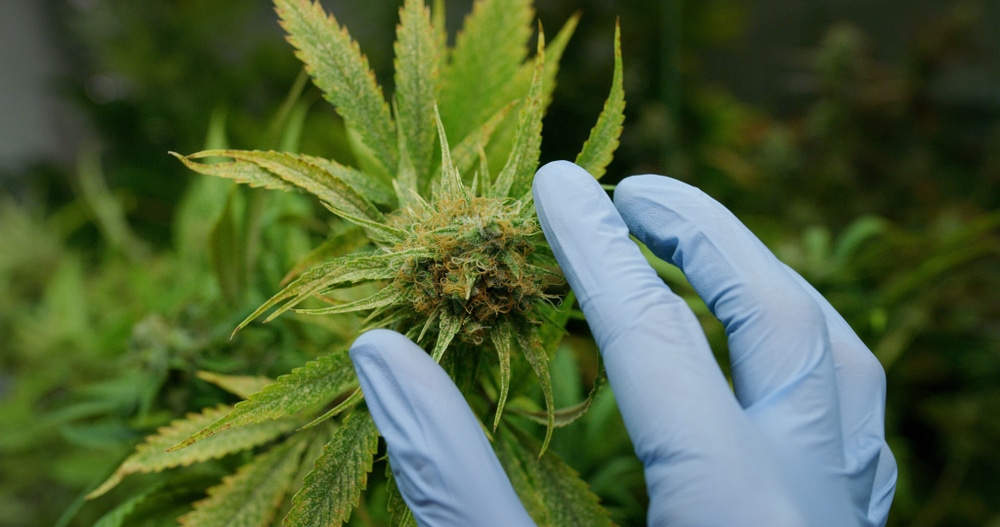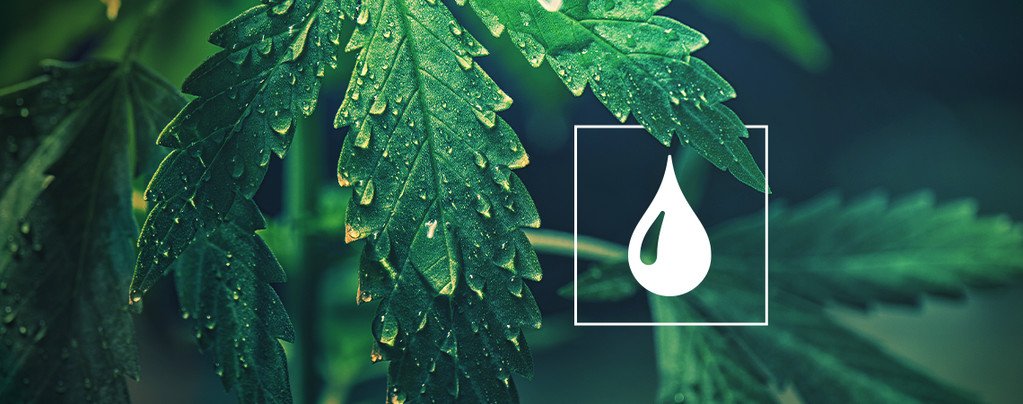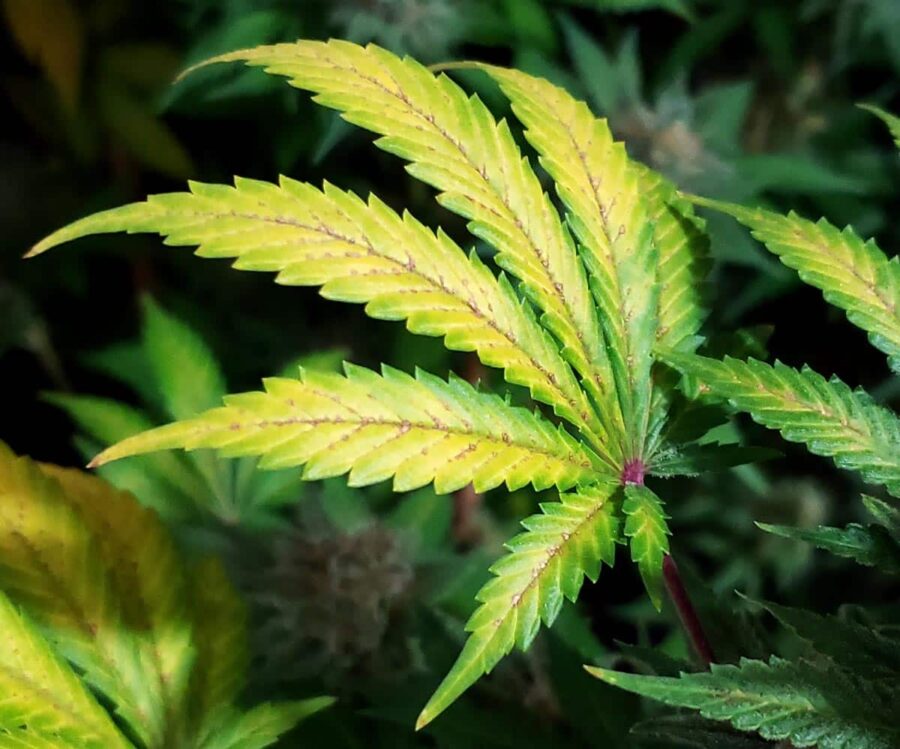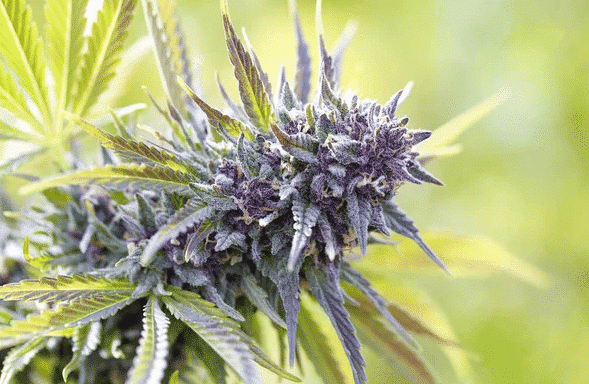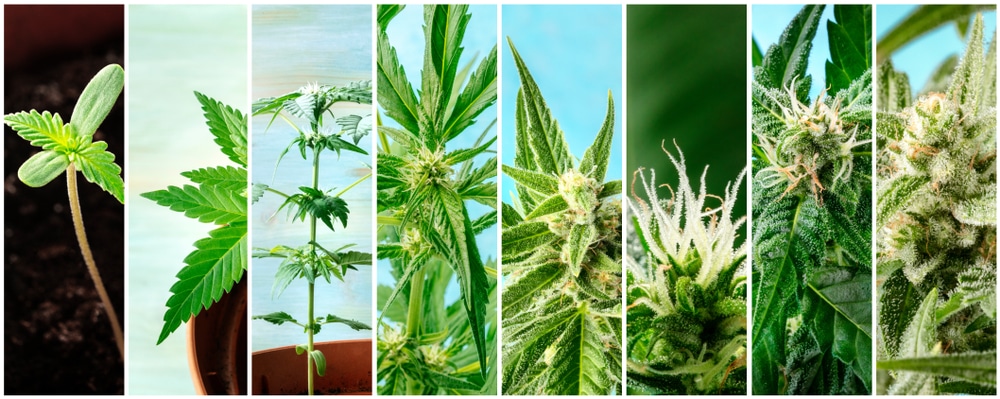No products in the cart.
Marijuana Education
Brown Spots on Weed: Causes and Solutions
There’s no greater joy than watching your cannabis plant grow tall and healthy. That’s why noticing signs of disease or issues like brown spots on weed can be heartbreaking.
These small dots are one of the most prevalent issues you may experience during cultivation. They harm the plant’s health by inhibiting photosynthesis, stifling development, and decreasing overall yield.
It may alarm you if you notice brown spots on your cannabis leaves, but it’s not the end of the world. Learning their causes and how to eliminate them can ensure you still get healthy plants with optimal yields.
Keep reading to learn everything you need to know about preventing and managing these brown spots.
What are the causes of brown spots on weed?
A healthy cannabis plant has a vibrant green shade with ideal pH levels, light, environmental conditions, and proper nutrients. Providing the correct growing supplies helps produce thriving crops.
An unhealthy plant may display signs, like brown spots on weed, due to various reasons:
- A shortage of nutrients and minerals.
- Excessive light.
- Low pH.
- Pest infestation.
- Plant stress from unfavorable conditions.
Let’s explore these causes more in-depth.
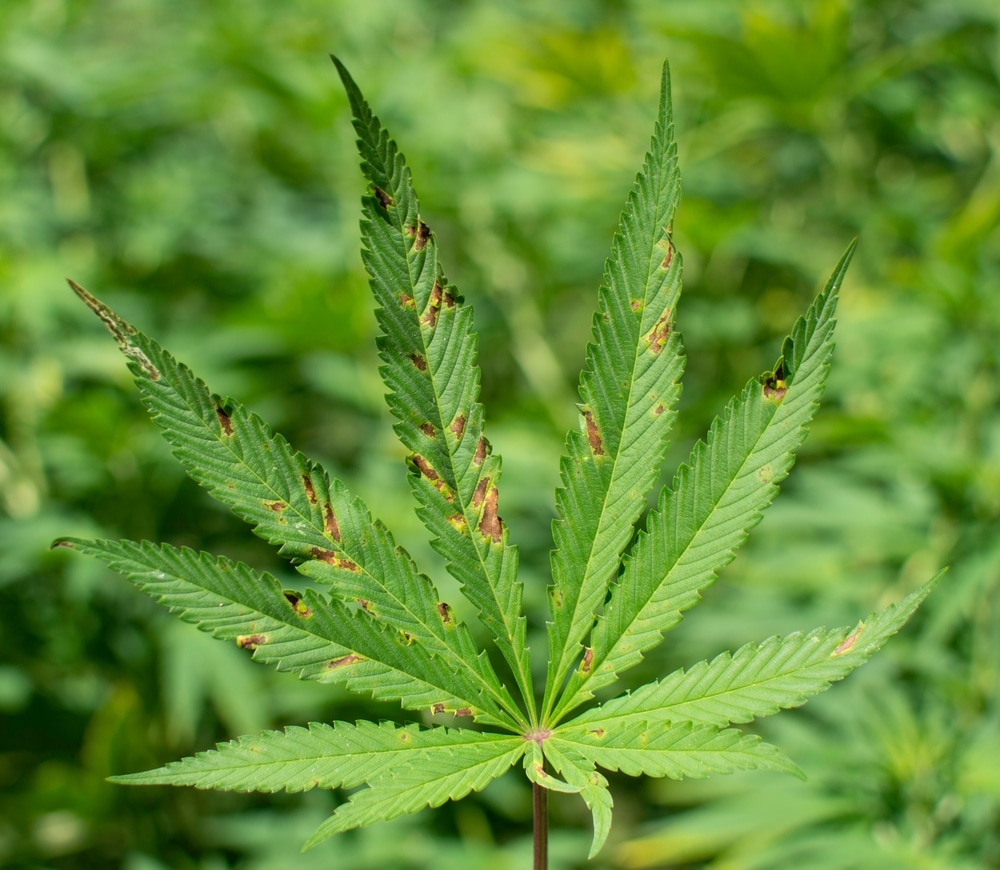
Nutrient deficiencies that cause black spots on cannabis leaves
Calcium is one of the primary nutrients that protect your plants against illness. It also facilitates the development of robust cell walls and healthy bud production.
Unlike spider mites that cause white blotches on pot leaves, a cannabis calcium deficiency leads to black or brown spots.
Some plants may not receive enough calcium when producing new leaves in the vegetative stage. In this case, you must provide them with more to avoid further issues.
If the leaves develop black patches during their vegetative stage and exhibit stunted growth, the plant may be experiencing calcium deficiency. Other signs include weak, easily-broken stems or undeveloped buds.
Be wary that too much calcium can also cause yellow leaves and burning at the tips.
Potassium is another essential nutrient for healthy growth, particularly during the flowering stage. It strengthens the leaves and stems and promotes bud development.
When cannabis faces potassium deficiency, its structure disintegrates, inhibiting proper growth and stunting yields.
Too much potassium can also cause problems by inhibiting the uptake of other nutrients.
Manganese deficiency results from factors related to the alkalinity or acidity of the water or growing medium. If your pH is too high (over 6.5), your cannabis plant may suffer from nutrient lockup and can’t utilize manganese in the soil.
Ensure you buy a reputable nutrient solution to provide all the necessary minerals and prevent issues like phosphorus deficiency.
Fungus infections that cause black spots on cannabis leaves
Leaf septoria, often known as “yellow leaf spot,” is a fungus that, left untreated, can kill a cannabis plant. Before spreading to the top sections, the disease manifests as yellow or brown patches on the lower blades as it prepares to blossom.
Delaying treatment for too long can have negative consequences, as the plant’s leaves gradually lose color and perish. Ensure you grow your crop in a conducive environment to prevent the spread of this hazardous fungus.
Maintain the temperature and humidity in your grow room constantly and trim the bushes to allow for more airflow. These measures are usually effective against all types of mold, including powdery mildew.
It’s more challenging to manage the environment when growing weed plants outside. Take extra precautions like installing a greenhouse or moving crops when the outdoor temperature and humidity levels are high.
Avoid planting in areas where leaf septoria has previously occurred, as spores may still be in the soil.
To treat a fungal infection, use natural antifungals, like neem oil, instead of chemical fungicides. Promptly responding to warning signs can save the plant so that it still produces healthy, substantial yields.
Replace the growing medium and clean the entire space when sowing a new crop.
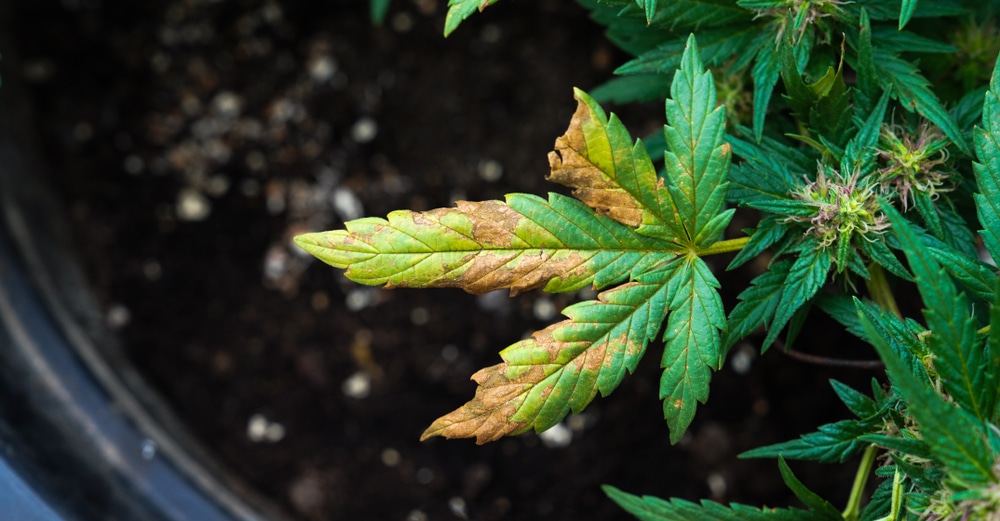
Does leaf septoria affect cannabis plants?
Marijuana leaf septoria is a fungal disease that damages cannabis plants when they start flowering.
It begins as little yellow and brown spots surrounded by a dark ring. These dots rapidly spread across weed leaves, causing them to turn yellow and brown before dying and falling off.
As the plant cells perish, a hole may appear where the leaf septoria spot was.
The earliest dots, ranging in diameter from 1–5 mm, typically develop on the bottom leaves before spreading upwards.
Cannabis leaf septoria could place the plant under stress, resulting in slow growth and lower yields. The fungus thrives in warm, moist environments, so one way to combat it is to maintain stable temperatures and ensure proper ventilation.
Difference between cannabis leaf septoria and calcium deficiency
Leaf septoria and calcium deficiency may exhibit similar symptoms but are easily distinguishable.
Consider these factors to determine what you’re dealing with:
The color and vitality of the leaves
If the plant suffers from leaf septoria, yellow dots on leaf blades turn brown or tan.
If it has a calcium deficiency, the bottom of the leaves turns yellowish-green, while the tip turns brownish-red and curls up. You might notice only one or two affected plant areas, particularly between the veins.
The location of the dots on the leaf
If the bottom leaves of your cannabis plant are discolored, it might indicate leaf septoria. The fungus infection spreads from lower sections, so removing them can prevent further issues.
A calcium deficiency typically occurs in new growth or the upper half of the plant or fan leaves exposed to too much light.
Fragile branches
When a marijuana plant has a calcium deficiency, it’s immediately noticeable as the stems and branches become brittle.
Leaf septoria may not affect the crop’s strength from the start, but the entire plant gets weaker if the illness isn’t treated.
Root strength
Your weed plants may start toppling over because of root rot, but brown spots harmful to marijuana leaves can also cause weakness in plant growth. These symptoms typically indicate a calcium deficiency, not leaf septoria.
To reduce the latter, grow high-quality hybrid weed resistant to mold and mildew.
Your plants will have sufficient calcium if you maintain a proper pH level and provide adequate nutrition.
How can I identify cannabis leaf septoria?
When leaf septoria is present, brown spots with a yellow ring emerge on infected sections. The earliest symptoms typically appear in older, lower regions.
The disease is common in tropical and subtropical regions, where high humidity, wet soil, or excessive moisture may promote fungal growth.
Symptoms of leaf septoria can be similar to most common nutrient deficiencies, so if you’re growing indoor cannabis plants, ensure you can distinguish between the two.
A leaf’s hue indicates whether it’s ill or has a nutrient deficiency. Typically, the yellow spots from septoria turn brown with a purple hue, while those without enough minerals are reddish-brown.
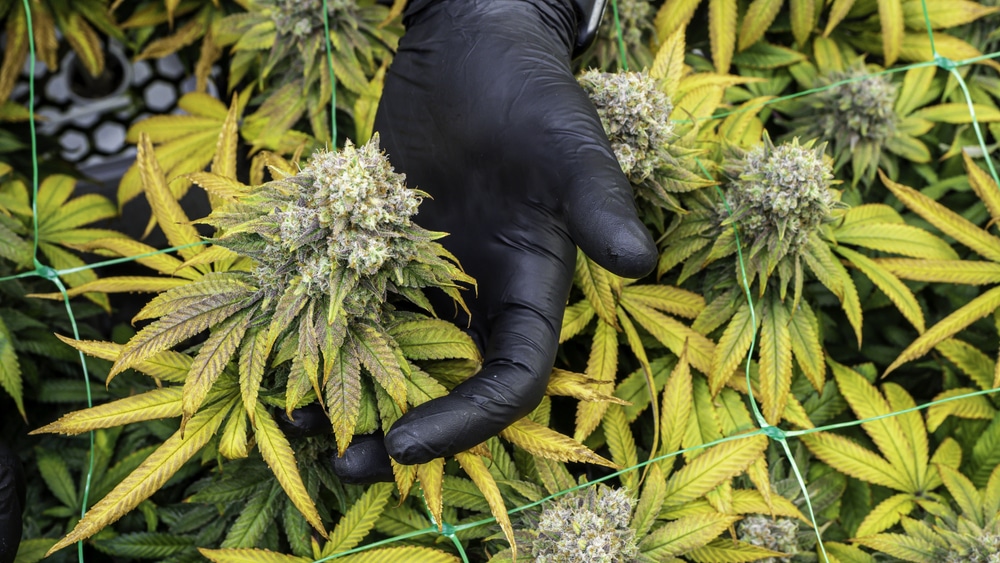
How can I treat leaf septoria in cannabis plants?
Below are several ways to treat leaf septoria:
Remove and discard infected leaves and other plant pieces.
If you discover cannabis leaf septoria early, remove the affected leaves. Don’t leave them on the ground around the plants, as the fungus may spread. Take them to a safe place away from your crop and destroy them.
Reduce moisture while raising the humidity in the room
Warm and humid environments are catalysts for cannabis plant diseases and the spread of fungi. By decreasing humidity, the conditions become less favorable for fungus growth.
Constantly monitor the grow room’s temperature and humidity at each step of a plant’s development. Reducing these factors can make the environment hostile to marijuana leaf septoria.
Use a dehumidifier to lower humidity levels and an air conditioner for cooler temperatures. Doing this can also help prevent cannabis light burn or heat stress.
Allow more air to pass through
Pockets of stagnant air in your grow room or greenhouse allow fungal spores to thrive. Ensure enough routes for carbon dioxide and oxygen to enter and exit the room.
Clip-on fans positioned above and below the plant canopy can assist in eliminating dormant air pockets.
Consider adding mulch on top
Use mulch to protect your plants by placing it between the soil and plants.
The objective is to construct a layer above the soil, making it difficult for septoria spores to migrate to the plant.
Use neem oil
Some growers use copper-based fungicides on their marijuana plants, but more natural sprays containing neem oil may be better. It’s a flexible substance that can treat a variety of cannabis-related pests and diseases.
Preventing future leaf septoria infections in indoor cannabis plants
The first step in treating leaf septoria is cutting off infected leaves. If you detect the disease early, it’s possible to cure it by removing and burning the afflicted lower sections.
Here are some tips to prevent infections in the future:
- Advancements in airflow: Air circulation is essential for cannabis growth and controlling pests and diseases. Adding fans and leaving space between indoor plants can increase ventilation.If you’re working outdoors, this may be more challenging, but pruning is an effective way to increase airflow around and throughout your plants. Remove the overgrown sections, so the leaves don’t touch or lie on each other.
- Use neem oil: It could effectively cure leaf spots, depending on the cause. Since the substance can separate from water quickly, you must spray all the leaves individually. Apply it to a small plant section first to determine its reaction.
- Apply fungicides: Sprays that fight fungus and pathogens and have a broad spectrum of activity are sufficient. Use a copper-based fungicide to provide additional protection. Follow the instructions on the label and keep the product away from your flowers.
Preventing future leaf septoria infections in outdoor cannabis plants
Outdoor or greenhouse cannabis growers should dry or discard the topmost layer of soil before sowing a new crop. Doing so eliminates fungal spores that may have survived from the previous season.
Remove leaves, weeds, and debris from the surface using a rake. Turning the soil can provide more air and allow the top layer to dry properly, killing leaf septoria spores.
Eliminate as many weeds and other surrounding plants as possible to reduce the danger of cannabis leaf septoria infections. The fungal spores are hardy and can survive the winter to grow the following year again if conditions are favorable.
It’s best to remove septoria-infected plants in a particular area altogether, then start afresh.
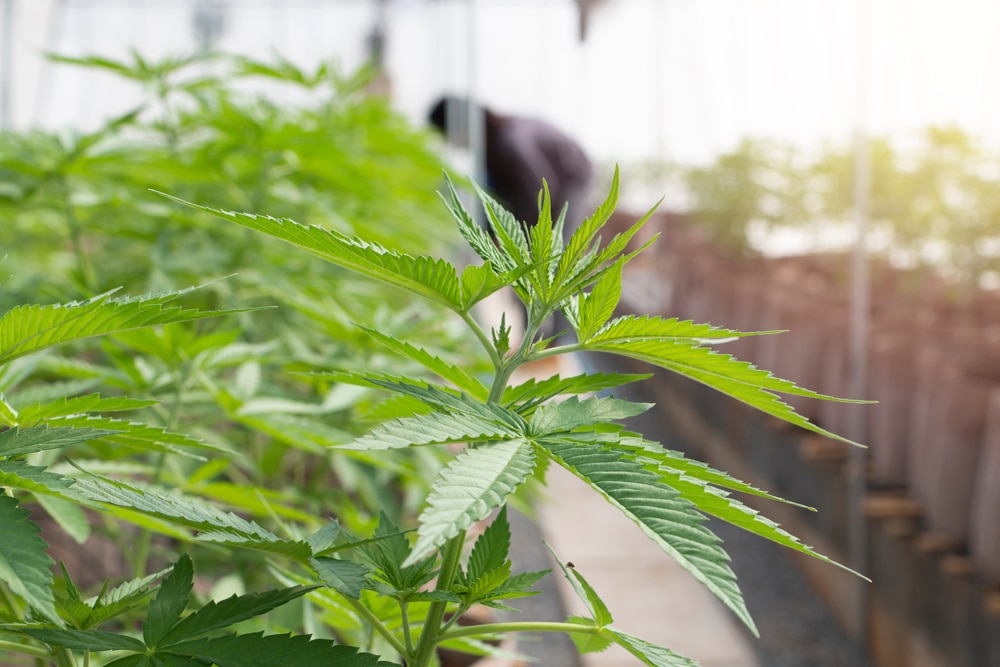
No more brown spots on cannabis plants
Preventing brown spots on your weed crops is better than trying to get rid of them after the leaves are infected.
Remember the following guidelines to avoid developing leaf septoria in the future:
- Don’t cultivate plants in the same location or soil the following year. If you plant your crops in the same place, dormant fungal spores are more likely to harm them.
- Clean your growing space frequently, especially if you’re growing indoors.
- Create and keep an optimal environment to promote the best plant health. Ensure the temperature and humidity levels are ideal and that there’s adequate air circulation around your crop.
- Consider pruning your plants to increase airflow and equal distribution.
At The Seed Fair, we provide the latest hacks and tips on caring for your cannabis crops to ensure optimal yields. We help you with the best strategies for protecting your plants from diseases and other infections, guaranteeing high-quality buds.
We’ve got your back if you’re looking for top-quality seeds with a germination guarantee. Find the best strains to relax, gain a boost, or alleviate specific symptoms.
FAQs about brown spots on weed
Have you still got questions about brown spots or other issues? Find the answers you need below.
What does it mean when weed has brown spots?
Large brown spots may appear on leaves due to insufficient calcium. These are distinct from cannabis leaf septoria. In the former, leaf veins turn yellowish-green and eventually brown; in the latter, they change to brown or tan.
Should weed have brown spots?
No, brown and black spots on cannabis leaves usually indicate an environmental imbalance. Remove or treat them if you notice any unusual dots.
What does bud rot look like in weed?
Initially, the decay appears white and wispy, and the bud becomes gray and black as it softens into a slimy texture. This infection begins when the surrounding nug decomposes, producing more spores that can spread to other plants.


